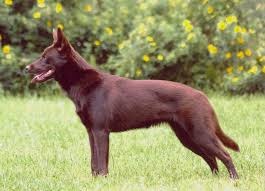Alternative Names: Kelpie, Barb
Country of Origin: Australia

History: The Australian kelpie originated around 1870 and is descended from British and Scottish Collies. Some believe dingoes and various breeds also played a role in its ancestry. It was bred to herd sheep; Australians say that the country was built on the back of the kelpie because of the large role the breed played in the development of the sheep and wool industry. Most Australia kelpies are still used as working dogs in Australia, Europe, and North America. However, they are becoming increasingly popular as companions, as well.
Physical Description: This is a muscular but agile, medium size dog. It is longer than it is high with a rounded skull and tapered muzzle, which is equal in length or slightly shorter than the skull. It has gold to brown, almond-shaped eyes and large, widely spaced prick ears. There is a strong neck and deep chest. The long brush tail is slightly curved when at rest and raised when active. The double coat has a dense undercoat and a short, straight, weather resistant outer coat. There is a ruff at the neck. It may be black, blue, or red, with or without tan markings, or all tan. They may have white on the chest and toes.
Height: 17 to 20 inches
Weight: 26 to 45 pounds
Temperament: This is a highly intelligent dog that makes distinct differentiation between work and rest. Active and intense at work, it is mild and easygoing at home. The kelpie is friendly but rarely affectionate and tends to be a one person dog that is devoted to its person.
Activity Level: High
Best Owner: The Australian kelpie does best with an active owner and the opportunity to participate in a job or activity. A rural environment suits it best, but it is adaptable. It gets along well with other dogs.
Special Needs: Exercise, job or activity, positive training
Possible Health Concerns: PRA




